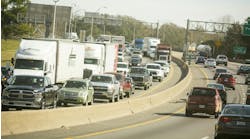When both consumer and business spending began evaporating in 2008 and then seemed to disappear completely last year, we turned to the spender of last resort — the Federal government. First the Bush Administration and then the Obama team that replaced it pushed a series of spending bills through Congress intended to stimulate the economy. In theory, injecting enormous sums of government money into the economy would end the slide and return us to growth by creating jobs, stable credit markets and demand for goods.
The largest of these stimulus packages by far was the American Recovery and Reinvestment Act of 2009 (ARRA). Passed in February when the U.S. economy seemed to be entering freefall, it authorized $787 billion in funds for tax cuts and emergency spending programs for education, health care and infrastructure. The only other recovery package that comes close to ARRA is the Emergency Economic Stabilization Act of 2008, which authorized up to $700 billion to prop up the U.S. credit market through the Troubled Assets Relief Program or TARP, as it's commonly known. However, Congress has only released $350 billion in TARP funds, and to date banks have received about $250 billion.
HEADED UP
Whether they attribute it to the Federal spending packages or an inevitable stage in economic cycles, most economists agree that we've reached the bottom of the downturn and should see the beginning of a slow recovery in 2010. The question for fleets is, when will this recovery begin to have a positive impact on their operations? And perhaps more immediately, will all those stimulus dollars bring some much-needed positive activity to trucking while the industry waits for that slow recovery to gather some steam?
To date, the impact of stimulus spending on trucking “has been marginal,” according to analyst Chris Brady, president of Commercial Motor Vehicle Consulting. “I think it did cushion the downturn a bit,” he says, but the only likely effect in 2010 will be seen by fleets involved in infrastructure construction. With $26.6 billion from ARRA specifically earmarked for highway, road and bridge construction, those projects should help construction fleets weather what Brady sees as a continued downturn in the overall construction market.
“Residential construction has bottomed, but the next shoe to drop [in 2010] will be a continued decline in nonresidential construction,” Brady says. Not only has excess capacity in commercial property brought a quick halt to new nonresidential projects, but state and local governments have also cut construction spending as tax revenues have dried up. “So, in general, road and highway construction will be decent in 2010 because of the stimulus spending, and residential won't decline anymore, but nonresidential construction will continue to trend downward.”
The 2009 stimulus legislation allocated “more funds for construction than any other piece of Federal legislation in history, but little of that was spent in 2009,” says Ken Simonson, chief economist for Associated General Contractors of America. Some state transportation departments were able to quickly turn the stimulus money into contract awards, but many other agencies had problems, either because the money was earmarked for programs like high-speed rail that were completely new or because they simply didn't have the contracting capacity to handle the sudden influx of money.
MORE CONTRACTS
Projects like water and wastewater treatment facilities were also delayed by “Buy American” restrictions on the funds since lack of activity in those areas over the years had driven U.S. suppliers out of business, according to Simonson.
“That will all be resolved in 2010, so we will see more stimulus money turning into contracts” this year, says Simonson. “But will that lead to more [construction-related] freight? I'd like to say so, but the stimulus alone won't do the job. Outside of [projects funded by] the stimulus, construction companies are telling us that the markets are still shrinking.”
Aside from specific spending tied to construction, the stimulus dollars might be expected to revive consumer confidence, and therefore consumption and all the freight tied to that consumption. The Car Allowance Rebate System (CARS), which is better known as Cash for Clunkers, certainly boosted new-car sales in 2009.
“What Cash for Clunkers did was clean out inventory so that dealers started placing orders for more product, which got General Motors and Chrysler plants up and running,” says Robert P. Farrell, executive director of the Automobile Carriers Conference at the American Trucking Assns. “That led to new product being shipped.”
“CARS was a one-shot stimulus,” adds Brady. “It helped dealers clear out bloated inventories in 2009. It helped fleets hauling auto parts, too, but that was an artificial spike since GM is now shrinking and closing plants.”
“For most of the past decade, [annual] sales averaged around 16.2 million units,” says Farrell. “We saw that drop to 13.2 million units in 2008, and [2009] sales are projected to be around 10.5 million units. That means that there is still a lot of excess capacity in the industry right now. Trucks are still parked.”
While it may not be directly tied to stimulus programs, Brady expects “no extended downturn in auto production, and we should see a moderate increase in auto sales in 2010.”
RISING TIDE
Farrell agrees. “2010 looks to be better than 2009,” he says. “Ford just announced a first-quarter production run of 550,000 units — a 58% increase over first-quarter 2009, and GM announced first-quarter production of 650,000 units, a 75% increase over first-quarter 2009. Business looks to be picking up.”
What about general freight conditions, the single largest component driving both for-hire and private fleet activity? Will the bulge of stimulus dollars fed into the economy begin to translate into higher overall consumption and more freight movements in 2010?
“While a rising tide lifts all boats, there's no direct linkage between stimulus dollars and freight that I can point to because not much of it went to consumers directly,” says economist and industry analyst Martin Labbe. If there was any positive impact last year, “trucks weren't running full anyway, so the equipment already out there could handle it,” he says. “No trucks that were parked were put back into service and no drivers rehired.”
Still, Labbe believes “2010 freight will grow over 2009 by 2 to 2.5%. But you have to remember we're coming off a really low number in '09.”
Brady agrees that stimulus spending won't have much of a direct effect on overall freight levels in 2010, but fleets should expect “moderate increases over '09.” However, compared to pre-recession levels in 2007, “they'll still be very low, maybe down 30%.”
In fact, Brady believes this freight recovery has already begun. “Retailers are beginning to replenish inventories in response to sales, and wholesalers are beginning to approach equilibrium in their inventories, so they will have to begin replenishing soon,” he says. “Producers still have to reduce inventory further, but they're getting there, and supply-chain inventories are also getting near equilibrium.”
SLUGGISH GROWTH
That said, Brady doesn't believe better inventory numbers alone will bring strong freight growth rates. “Strong growth would have to be driven by consumer and business spending,” he says.
Significantly lower home values and a severe decrease in the value of household assets have changed consumer habits, he believes. “Consumers are paying off debt and increasing savings,” Brady says. Combine that with a weak labor market and flat personal income, “and consumers have less money for expenditures that drive freight growth. I don't think that's a trend that will reverse quickly, so there will be sluggish growth in consumer spending.”
On the business side, excess capacity, continued tight credit and pressure to strengthen balance sheets by reducing debt “will put downward pressure on business expenditures,” says Brady.
All that adds up to just “moderately higher freight volumes” in 2010 despite a spillover in stimulus package spending from last year. “And fleets already have the capacity in place to meet that level of growth,” says Brady.
Outlook 2010: Truck sales stay low
Although manufacturers didn't sell too many trucks in 2008 or 2009, don't expect to see a surge in sales this year, according to industry analysts. Low utilization of existing equipment in past years, tight credit conditions, and only a moderate increase in freight volume from severely depressed levels will all combine to keep truck sales below historic replacement levels, especially in Class 8.
A jump in Class 8 sales seen in the last quarter of 2009 should tail off in the beginning of 2010. Fleets placed those orders to avoid the significant price increase that will come with diesel engines meeting the new 2010 emissions requirements, but truck makers will use up their supply of the older, less expensive engines early this year. Most, in fact, stopped taking orders for those trucks before the end of 2009.
Excess truck capacity in the weak freight markets of the last two years means fleets have accumulated far fewer miles on heavy-duty tractors. So despite an increase in the average age of Class 8 trucks from 7.87 years in 2009 to 8.11 years in 2010, carriers believe that they have enough useful economic life left in that aging fleet to handle what will only be a moderate increase in freight.
As 2010 progresses and fleets begin to have confidence in slowly improving freight conditions, they will begin to start replacing those older trucks, says analyst Chris Brady, president of Commercial Motor Vehicle Consulting. Weak balance sheets and tight credit, however, should still keep Class 8 sales below normal replacement volumes, he believes.
Brady sees a similar scenario playing out in both the medium-duty Class 6-7 and midrange Class 3-5 markets, especially with private fleets in construction, wholesale and retail markets reducing business capacity and therefore reducing private fleet requirements.
The one stimulus-related impact on truck sales in 2010 will be a negative one in the eyes of Martin Labbe, economist and industry analyst. “TARP [Troubled Asset Relief Program] will have a big impact,” says Labbe. “Banks are not making loans because they don't want to attract Federal regulatory oversight by letting their loan-to-capital ratio get out of whack. If you stop making loans, you improve that ratio with cash. And financing new trucks is risky business, so that will have a negative impact on the availability of capital to fleets and their ability to purchase trucks.”
— JIM MELE


